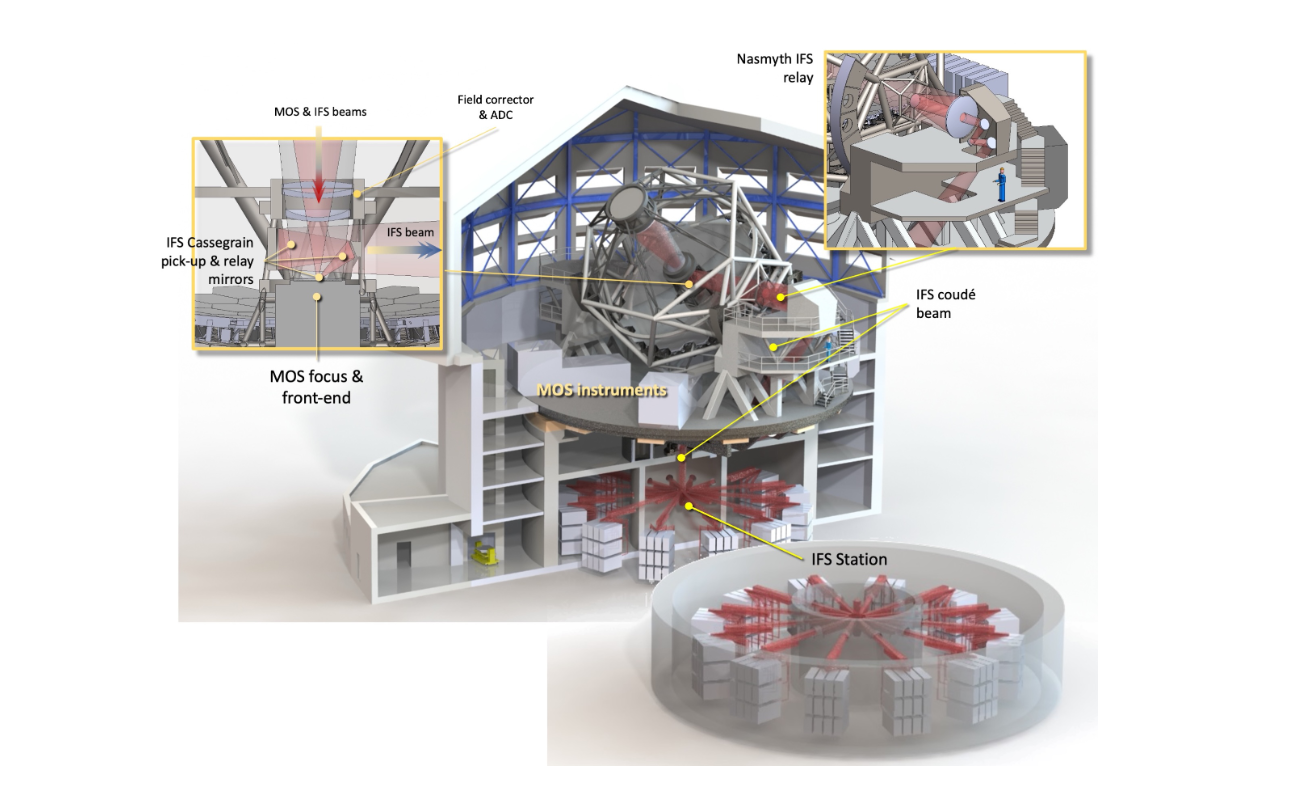The Wide-field Spectroscopic Telescope
A 12-m telescope fully dedicated to multi-object spectroscopy.

In the white paper (of almost 200 pages) we try to answer the question: What transformational science can we do in 10-15 years from now with a 12 metre telescope fully dedicated to multi-object spectroscopy?
The telescope and instruments
WST is a project of a 12-m telescope fully dedicated to multi-object spectroscopy (MOS). It is designed to have a large field of view (3.1 sq. deg.), enabling the observations of multiple targets at once. It is planned to be equipped with three types of instruments operating simultaneously:
- A low-resolution (R ~ 4000) spectrograph with ~20 000 fibres covering from the violet, 370 nm, to the near-infrared at 970 nm;
- A high-resolution (R ~ 40 000) spectrograph with 2000 fibres in 3 or 4 windows still to be chosen;
- A giant panoramic integral field spectrograph (IFS) in the centre of the field of view, covering 3x3 arcmin2 but able to patrol an area of 9x9 arcmin2.
In scientific capability these requirements place WST far ahead of existing and planned facilities. Given the current investment in deep imaging surveys and noting the diagnostic power of spectroscopy, WST will fill a crucial gap in astronomical capability and work synergistically with future ground and space-based facilities.
The white paper is organised in thematic chapters covering: i) time-domain astrophysics; ii) exoplanet, stellar, and Galactic astrophysics; iii) resolved stellar populations; iv) extragalactic astrophysics; and v) cosmology.
Exoplanet, stellar, and Galactic Science with WST
SAGA Team members are involved in the WST Science Team and co-leading the working group responsible for the exoplanet, stellar, and Galactic science case. This specific chapter contains a discussion of four main broad science cases that have driven the current technical requirements of the WST instruments in terms of spectral resolution, efficiency, target numbers, radial velocity stability, and field of view:
- Origins of the elements;
- Origins of the Milky Way system;
- Origins of stars and planets;
- Evolution of stars.
WST will be fundamental for the systematic observation of faint stellar targets discovered by Rubin LSST and Euclid in the Milky Way and beyond, using the low-resolution mode. In this mode, WST has the potential to obtain almost 108 stellar spectra in 10 years.
The high-resolution spectroscopy mode is unique and essential for enabling precision chemical abundance analysis of weak lines in targets that cannot be explored at this level of detail for large samples by other facilities. In this mode, WST has the potential to obtain almost 3.3 x 107 stellar spectra in 10 years. That is one order of magnitude more than will be available from previous MOS surveys at the same resolution. Furthermore, the careful choice of wavelength coverage will be crucial to open access to key spectral features that are absent from other surveys and will significantly improve the accuracy and range of stellar types with measurements of numerous additional chemical elements.
The IFS will also enable detailed investigations of resolved stellar populations in densely populated regions such as the Bulge and the central regions of dense stellar systems such as star clusters and dwarf galaxies.
Text by Rodolfo Smiljanic (with excerpts from the white paper)

